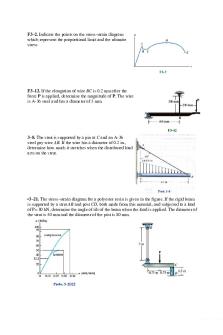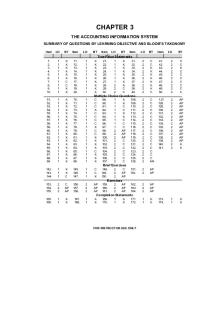Neuroscience Textbook Ch3 PDF

| Title | Neuroscience Textbook Ch3 |
|---|---|
| Course | Neuroscience |
| Institution | New York University |
| Pages | 4 |
| File Size | 82.5 KB |
| File Type | |
| Total Downloads | 70 |
| Total Views | 136 |
Summary
txtbook summary ch 3 -- professor: Gerald Voebel ...
Description
Neuroscience Textbook Ch. 3 EPSP: Na/Ca influx IPSP: local hyperpolarization Cl influx/K efflux EPSP and IPSP can sum Presynaptic facilitation: DEPOLARIZAES second neuron Ca influx into second neuron Action potential duration increases Presynaptic inhibition: think of a beach to block out painful thoughts of cold HYPERPOLARIZES second neuron Action potential duration decreases Ca influx reduced Neuromodulators- released into ECF Neurotransmitters – released into synaptic cleft Iontropic Metabotropic (2nd messenger g-proteim) Slow acting neurotransmitters regulate fast transmission by controlling the amount of neuro released Ach = PNS Glutamate: neuronal cell death Glycine: inhibits postsynapse in spinal/brainstem GABA: inhibits CNS at interneurons in spinal Glycine + GABA: prevent neuronal overactivity (prevent seizures and dystonia) Dopamine – produced in the substanita nigra Motor activity, cognition, addiction/reward motivation Coke and amphetamine – prevent dopamine reuptake to prolong dopamine activity in the synapse Norepi Increases attention to sensory PNS- adrenal gland CNS- brain stem, hypothalamus and thalamus Overactivity/high NE levels = fear and PTSD hallucinations Serotonin Affects mood, pain perception, arousal
High = alert Low = depression Prozac (flouoxetine) blocks serotonin reuptake
Histamine Hypothalamus Hormonal function and increased arousal Substance P peptide Stimulated nerve endings at injury site CNS – carries info from spinal to brain Galaline Inhibits insulin Controls food intake Opioids Inhibit CNS neurons responsible for pain Spinal cord, hypothalamus, gray matter Calcitonin gene-related peptide Phosphorylates Ach to decrease the likelihood Ach will bind to receptor Nitric Oxide Regulates vascular system Diffused through cell membrane to reach receptor LTP 1st messenger: neurotransmitter 2nd messenger: G-protein 3rd messenger: Ca G-Protein- amplifys signals with cascade Activate genes that make various transmitters Open ion channels Modualate Ca o Internal stores of Ca open G-Protein Second Messenger – Metatropic 1. Receptor changes shape when transmitter binds 2. Activtes G-protein 3. Gprotein subunits (a,b,y) break free and bind to membrane ion channels 4. Ionchannel changes shape and opens 5. Subunits deactivate RTK
Adds phosphates to tyrosine then phosphorylates molecules to initate signal cascade Dysfunction: MS and schizo
Ach Receptors Nicotinic o Ionotropic Na/Ca in to depolarize o Alzheimers – Nicotinic receptors lost Fix: increase Ach Muscarinic o G-protein receptors o Smooth muscle Glutamate Receptors AMPA o Fast depolarization of postsynaptic NMDA – voltage and ligand gated o Glutamate must be bound to receptor AND membrane depolarize SIMULTANEOUSLY o Produce LTP o High glutamate = neuronal death o Overactivity of NMDA receptors = epilepsy GABA Receptors GABAa o Opens Cl channels to hyperpolarize o Decreases anxiety GABAb o Slow acting- G protein receptor Dopamine Receptor – Metatropic Stops activity of Ca channel L-DOPA precursor to dopamine Alters movement, motivation and thinking Norepi Receptor Alpha in gut – relaxation Beta in the heart- contraction Serotonin Low levels- depression Fluoxetine blocks serotonin reuptake so serotonin stays in receptors for longer Ligand Na/K channels Agonist- binds to receptor and mimics transmitter effects Antagonist- binds to receptor to prevent release of transmitter
Myasthenia Gravis Autoimmune attacks nicotinic receptors on muscle cells Normal Ach amounts but no receptors to receive them Muscle use leads to weakness Eyelids droop] Fix: decrease Ach...
Similar Free PDFs

Neuroscience Textbook Ch3
- 4 Pages

Textbook Solution ch3
- 3 Pages

CH3
- 45 Pages

N8 - neuroscience
- 4 Pages

Social Neuroscience
- 6 Pages

Neuroscience BASICS
- 1 Pages

Ch3 Examples
- 6 Pages

Ch3 Solutions
- 5 Pages

Ch03 - CH3
- 52 Pages

CH3 Companies
- 3 Pages

Quiz 2 Neuroscience
- 2 Pages

6 - Animal Neuroscience
- 15 Pages

10. neuroscience + emotion
- 4 Pages

Neuroscience Webquest 3
- 1 Pages

Neuroscience Chapter Notes
- 46 Pages
Popular Institutions
- Tinajero National High School - Annex
- Politeknik Caltex Riau
- Yokohama City University
- SGT University
- University of Al-Qadisiyah
- Divine Word College of Vigan
- Techniek College Rotterdam
- Universidade de Santiago
- Universiti Teknologi MARA Cawangan Johor Kampus Pasir Gudang
- Poltekkes Kemenkes Yogyakarta
- Baguio City National High School
- Colegio san marcos
- preparatoria uno
- Centro de Bachillerato Tecnológico Industrial y de Servicios No. 107
- Dalian Maritime University
- Quang Trung Secondary School
- Colegio Tecnológico en Informática
- Corporación Regional de Educación Superior
- Grupo CEDVA
- Dar Al Uloom University
- Centro de Estudios Preuniversitarios de la Universidad Nacional de Ingeniería
- 上智大学
- Aakash International School, Nuna Majara
- San Felipe Neri Catholic School
- Kang Chiao International School - New Taipei City
- Misamis Occidental National High School
- Institución Educativa Escuela Normal Juan Ladrilleros
- Kolehiyo ng Pantukan
- Batanes State College
- Instituto Continental
- Sekolah Menengah Kejuruan Kesehatan Kaltara (Tarakan)
- Colegio de La Inmaculada Concepcion - Cebu
